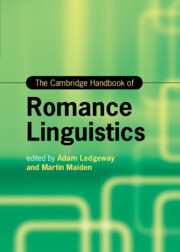Book contents
- The Cambridge Handbook of Romance Linguistics
- Cambridge Handbooks in Language and Linguistics
- The Cambridge Handbook of Romance Linguistics
- Copyright page
- Dedication
- Contents
- Figures
- Tables
- Contributors
- Abbreviations
- 1 Data, Theory, and Explanation: The View from Romance
- Part One What Is a Language?
- Part Two Phonetics and Phonology
- Part Three Morphology
- Part Four Syntax
- Part Five Semantics and Pragmatics
- 22 Word Meanings and Concepts
- 23 Key Topics in Semantics: Presupposition, Anaphora, (In)definite Nominal Phrases, Deixis, Tense and Aspect, Negation
- 24 Speech Acts, Discourse, and Clause Type
- 25 Address Systems and Social Markers
- 26 Information Structure
- Part Six Language, Society, and the Individual
- Index
- References
23 - Key Topics in Semantics: Presupposition, Anaphora, (In)definite Nominal Phrases, Deixis, Tense and Aspect, Negation
from Part Five - Semantics and Pragmatics
Published online by Cambridge University Press: 23 June 2022
- The Cambridge Handbook of Romance Linguistics
- Cambridge Handbooks in Language and Linguistics
- The Cambridge Handbook of Romance Linguistics
- Copyright page
- Dedication
- Contents
- Figures
- Tables
- Contributors
- Abbreviations
- 1 Data, Theory, and Explanation: The View from Romance
- Part One What Is a Language?
- Part Two Phonetics and Phonology
- Part Three Morphology
- Part Four Syntax
- Part Five Semantics and Pragmatics
- 22 Word Meanings and Concepts
- 23 Key Topics in Semantics: Presupposition, Anaphora, (In)definite Nominal Phrases, Deixis, Tense and Aspect, Negation
- 24 Speech Acts, Discourse, and Clause Type
- 25 Address Systems and Social Markers
- 26 Information Structure
- Part Six Language, Society, and the Individual
- Index
- References
Summary
This chapter reviews the role played by linguistic evidence from the Romance languages in shaping contemporary semantic research. The discussion focuses on a selection of phenomena that have important ramifications for the form–meaning mapping (presupposition, anaphora, (in)definiteness, deixis, tense, negation). For each phenomenon some particularly remarkable cases are discussed, for which research into Romance languages has substantially contributed to theoretical models and analytical advances in the field of semantics. At the same time, a number of outstanding issues are singled out, for which Romance data may prove decisive in future research. From the non-exhaustive overview provided in this chapter, two conclusions emerge most clearly. First, Romance linguistics has proven to be very influential for semantic research thanks to the wide display of microvariation within the Romance family, which represents an ideal testing ground for theories of the form–meaning interface. Second, the diachronic depth that can be reached in examining Romance data is instrumental in opening up new perspectives for research into the historical development of semantic categories.
Keywords
- Type
- Chapter
- Information
- The Cambridge Handbook of Romance Linguistics , pp. 695 - 727Publisher: Cambridge University PressPrint publication year: 2022



